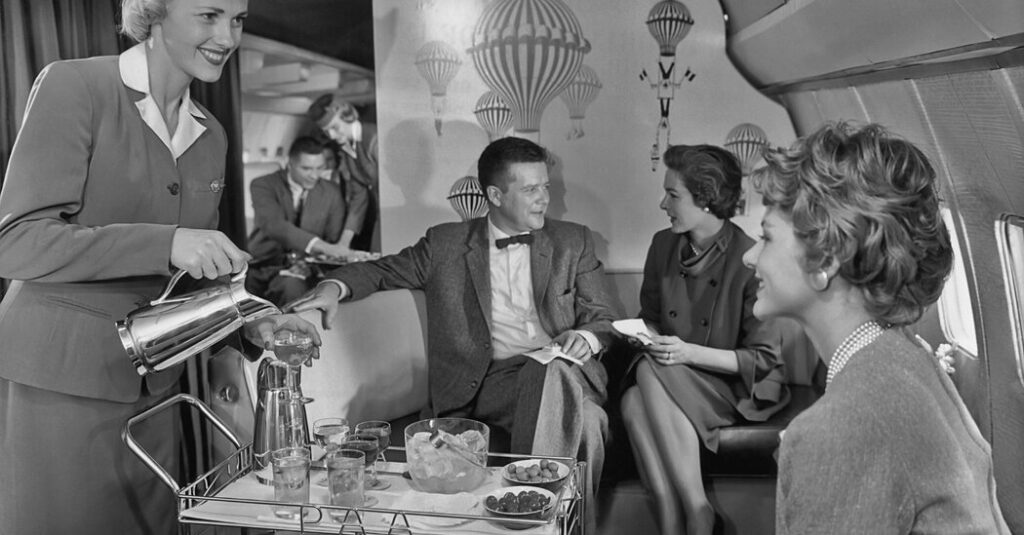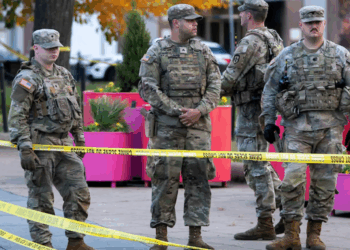When Pan Am introduced its first jetliner, a Boeing 707 named “America,” with an inaugural flight on Oct. 26, 1958, a marching band performed for the 111 passengers who followed a red carpet to their Paris-bound plane. The women on the tarmac at Idlewild Airport, now John F. Kennedy International in New York, wore heels and pearls. Men wore suits and hats.
During the ensuing “Jet Age,” passengers entertained themselves on flights by playing chess and reading the newspaper. They dined on hot meals served on china and often prepared by famous restaurants, even on flights lasting only an hour.
And because there were fewer flights, there were fewer delays.
This holiday travel season, flying looks a lot different — a fact that Sean Duffy, the U.S. secretary of transportation, took issue with last week. In a video that evoked the long-lost days of 1958 air travel, Mr. Duffy asked passengers to dress up and mind their manners, but made no mention of the dwindling amenities offered to present-day travelers.
Passengers on a 1958 flight could expect a wool blanket embossed with the carrier’s logo to keep them warm, along with a large pillow and a padded eye mask. In 2005, many major airlines got rid of complimentary blankets and pillows on domestic flights because of the cost of cleaning them. Mr. Duffy suggested later that airlines need to serve healthier snacks.
“Air travel today is cheap enough to be accessible to the average American, which is a wonderful thing,” said Shea Oakley, 57, an aviation historian. “But the glamour, the allure, the comfort and the exclusivity of flying in the 1960s — those days are gone.”
Since 1958, which marked the turn to jet engine planes from propeller planes, physical airplanes have changed very little, Mr. Oakley said. The 1970s saw the rise of the jumbo jet, the Boeing 747, but other than getting wider (and paradoxically, at least for budget travelers, more cramped), the planes are largely the same. What has changed is what happens inside.
Until the Airline Deregulation Act of 1978, which ended federal control of the aviation industry, fare prices, routes and even what meals were served were decided by the now-defunct Civil Aeronautics Board. Airlines would apply to fly a certain route, and it could take years to be approved or denied, Mr. Oakley said. The regulations tried to ensure that airlines would make a certain standard profit and the businesses “were almost seen as a public utility,” he said.
As a result, it was common for planes to fly half full, as mostly businessmen or wealthy vacationers were among the few who could afford it. Tickets to fly Pan Am’s “America” were astronomically expensive — $505 for a “deluxe” one-way ticket and $272 for an economy class one-way flight, the equivalent of $5,639 and $3,307 today.
Much was made of the extra space. According to Flights.com, legroom, which has dwindled to around 31 inches, was three to six inches greater in the ’50s and ’60s. National Airlines, later taken over by Pan Am, served a full breakfast on its hourlong morning flight from Miami to Jacksonville, Fla., Mr. Oakley said.
“It was the golden age for the passenger, if you could afford it,” he said.
And in the 1970s, many planes had multiple lounges where passengers could drink and socialize. Ganesh Sitaraman, the author of “Why Flying Is Miserable,” said that certain planes even had piano bars. Because the industry was regulated, the airlines were competing on quality of service. The space used for these common spaces is now filled with more seating, Mr. Oakley said.
Deregulation brought in budget airlines, such as People Express, which offered flights from Newark to Boston for as little as $19 in 1984, or about $59 today. Many of those airlines came onto the market quickly, but soon petered out. People Express merged with Continental Airlines, which eventually merged with United Airlines in 2012.
“There’s actually less competition now than there was during the regulated period,” Mr. Sitaraman said. “We have a system of real consolidation. I mean, we have four major airlines now, and that’s it.”
Those four airlines — United, American Airlines, Delta and Southwest — control 80 percent of the industry today, which has led to higher ticket prices, though still far lower than in the Jet Age. That consolidation, Mr. Sitaraman said, gives passengers fewer choices and gives airlines enormous power over the people who fly them. And while a ticket in 1958 might have seemed astronomically expensive, a passenger at that time received a larger seat, was able to bring their bags on board and received a meal.
“Now, if you’re thinking about a regular coach flight, you’re not getting any of those things,” Mr. Sitaraman said. “So if you’re just looking at those prices and you’re thinking about that casually, you’re not comparing apples to apples, right?”
Mr. Oakley said there used to be a joke that the best way to make a small fortune was to start with a large fortune and get into the airline business. It was a difficult industry to make money in — until airlines realized that everything that was taken for granted as a freebie, such as luggage, meals and check-in services, could be unbundled and charged for separately. That has made airlines a lot of money.
“You feel like the next thing they’re going to be asking you is to pay for your seatbelt and to use the lavatory,” Mr. Oakley said.
Mr. Duffy said in a news conference on Monday that this Thanksgiving was projected to be the busiest on record, with 31 million passengers set to fly. He reiterated his request that people not wear pajamas and slippers.
Mr. Oakley said that was no problem for him — he has never so much as worn jeans on an airplane, opting for a sports coat and slacks on most flights.
Follow New York Times Travel on Instagram and sign up for our Travel Dispatch newsletter to get expert tips on traveling smarter and inspiration for your next vacation. Dreaming up a future getaway or just armchair traveling? Check out our 52 Places to Go in 2025.
Claire Fahy reports on New York City and the surrounding area for The Times.
The post Sean Duffy Longs for the ‘Golden Age’ of Air Travel. What Was That Like? appeared first on New York Times.




